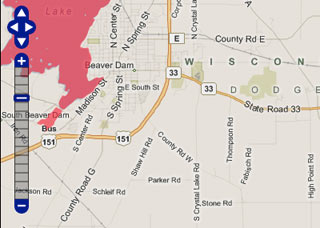Where the invasive things are — and where they could be
Researchers at the Center for Limnology have launched a new Web site to help assess the threat of aquatic invasive species in Wisconsin’s lakes.

The interactive mapping tool includes more than 12,000 Wisconsin lakes, color-coded to reflect their environmental suitability for zebra mussels.
“This is an issue of increasing relevance in Wisconsin, and there has been a demand for scientific guidance as counties, lake organizations, and the Department of Natural Resources (DNR) try to stop their continued spread,” says Jake Vander Zanden, a UW–Madison zoology professor and invasive species expert. “This knowledge will be helpful for managers in deciding how to prioritize their management activities and efforts.”
With support from the Wisconsin DNR and the Ira and Ineva Reilly Baldwin Wisconsin Idea Endowment, the researchers traveled around the state, talking with local and regional invasive species managers and other user groups about what information would be most useful.
Armed with this user-driven input, they partnered with the UW–Madison Applied Population Lab to develop an interactive Web site displaying a map of Wisconsin with more than 12,000 lakes color-coded to reflect their environmental suitability for zebra mussels. The site can be found at http://www.aissmartprevention.wisc.edu.
“We used information about the environment to forecast where a species can live, looking for matches between the environment and species requirements,” says Vander Zanden.
“In the case of zebra mussels, the overriding factor is calcium concentration, because they need calcium to build their shells,” explains Mona Papes, a UW–Madison postdoctoral fellow working on the project.
Based on the mussels’ physiological requirements, the scientists developed a three-tiered system that classifies lakes as suitable, borderline or unsuitable. In addition, the map indicates where the invasive shellfish already live. Local managers can combine this information with their own knowledge of lake use and other factors when deciding how to manage and prioritize their resources.
The site may also help homeowners and other lake users understand management efforts.
“The hope is that this tool will encourage citizens to think about the broader context of how their lake fits in a landscape where some lakes are invaded and some aren’t,” Vander Zanden says. “Management has to be regional, it can’t be lake by lake.”
Zebra mussels are already found in about 80 inland lakes in Wisconsin, concentrated in Waukesha County and the Fox River Valley. Very few mussels have made their way to the northern part of the state, Vander Zanden says.
“That’s one reason we think it’s important to be thinking about zebra mussels in that area, because they’re not there yet. They’re in a position that they can still do something about it,” he says. He hopes the new tool will help that effort. “If you’re a manager in Vilas County and you’re worried about invasive species, this tells you which lakes you need to focus on.”
The researchers are in the process of expanding the site with maps for additional species including rainbow smelt, round goby, rusty crayfish, spiny water flea and Eurasian water milfoil.
In the spirit of the Wisconsin Idea, the researchers have also held workshops around the state to solicit feedback and help get the information into the hands of those who need it.
“As scientists, we publish our findings in scientific journals, but the people who live on the lakes will never, ever read those papers,” Vander Zanden says. “We want to get the word out there to the stakeholders, the users and the general public.”



